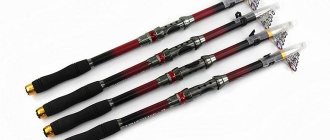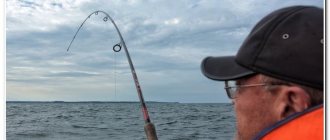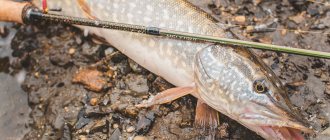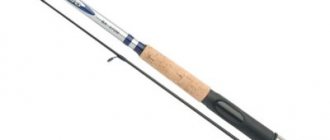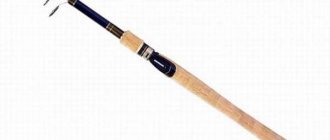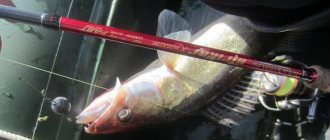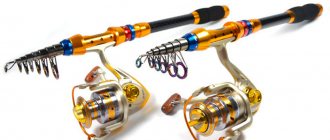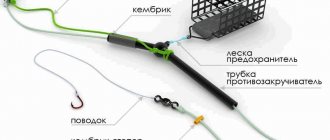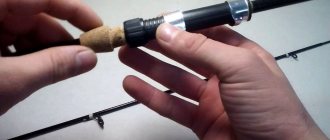- November 3, 2018
- Equipment
- Svetlana Lingovskaya
Fishing professionals and novice fishermen know firsthand what spinning is. It is he who enjoys the greatest popularity among all fishing equipment. But before buying a tool, you need to take into account many nuances and the main thing is to determine for yourself: which spinning rod is better - plug-in or telescopic. We present an overview of these tools according to all criteria, which will help you make the right choice.
Types of spinning rods
Spinning is the fisherman's main tool, with which you can use various baits to catch fish. Most often they are made of carbon (carbon fiber) and fiberglass. Carbon fibers are characterized by rigidity, low weight and elasticity, but can break even with minor mechanical impact. Fiberglass spinning rods are heavier in weight, but are durable and reliable.
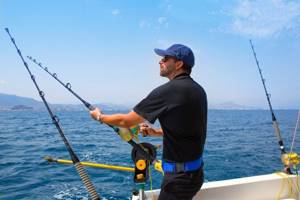
Types of spinning rods:
- telescopic - the rod in it extends, like a telescope (spyglass), hence the name;
- plug-in - the elbows are connected to each other by tubes.
How to choose the right spinning rod for a beginner? Professionals note that first you should give preference to a cheaper option, that is, a telescopic rod. Having tried it in operation, you can move on to a more expensive and reliable option - a plug-in one. Even though telescopic fishing rods break down faster and more often, they can be easily repaired. If a plug rod breaks, you just have to throw it away.
Advantages and disadvantages of telescopic spinning rod
In order to decide which spinning rod is better - plug-in or telescopic, we suggest that you familiarize yourself with each type in more detail.
Advantages of telescopes:
- small size, especially when folded, so it is easy to transport;
- a variety of models that differ in rod length (this depends on the nature of the fishing itself and the size of the water area where the fish will be caught);
- affordable price;
- Possibility of repair in case of breakdown.
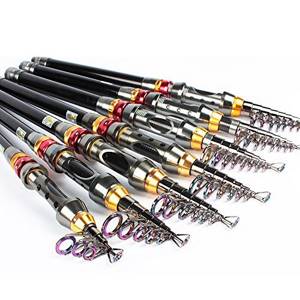
While there are obvious advantages, there are also disadvantages to the work. Tests of telescopic spinning rods show that the rods are not reliable and durable, especially the body.
Also, despite its compactness, the weight of the tool is quite large. And if you compare the device with the plug-in type, it is clearly inferior in casting range.
Which feeder is better - telescopic or plug-in?
There are two main types of feeder rods – telescopic feeder rods and plug-in rods. The first ones are usually purchased by beginners. Experienced fishermen, who have had a lot of practice, choose plug-in rods: a plug-in feeder is much more convenient for casting, as well as the ability to install rings in convenient places, which is not possible when using a telescopic feeder. At the same time, a feeder telescope is more convenient to transport and much cheaper than a “plug”.
A budget “telescope” does not mean low-quality
Among budget telescopic feeders, rods and “Trimm” stand out. Volzhanka telescopic feeders are made of durable high-modulus fiberglass. On average, the optimal weight of a feeder varies from fifty to sixty grams, and the casting range is about fifty meters. This is a fast action rod that has quite a few disadvantages. These include too small rings on the tips, far from the standard sizes. In addition, there are also the standard “diseases” of all telescopic feeders - a thick handle and a hum when biting. But all this is more than compensated for by the very, very budget price. Trimm rods are often made from a high-tech composite. The casting is much further compared to the rods of the previous company - on average about seventy meters with the same weight of the feeder. The disadvantages are also common “illnesses”, which are also more than compensated for by the low cost.
Thus, it becomes obvious that with the correct selection of parameters and following the recommendations outlined in this article, it is quite possible to purchase a decent telescopic feeder rod at a very budget price. Of course, a plug rod is more suitable for professional or sport fishing - but why overpay in vain if your main goal is simply to enjoy the fishing process itself? Be careful when choosing your first feeder - and you will be provided with complete rest from the hustle and bustle.
Which spinning rod is better, plug-in or telescopic – we will try to answer in this article. The basic principle of fishing is to cast the bait and draw the line towards you using a reel. The main specialization of spinning is catching predatory fish. It can be used when fishing from a boat or in an overgrown coastal area as a bottom rod.
The fishing rods offered for sale are made:
- made of carbon;
- fiberglass.
The design provides the ability to fold the spinning rod, which greatly facilitates its transportation. We are talking about plug-in and telescopic spinning rods. The components of a fishing rod are a reel with fishing line and guide rings.
Manufacturers set us difficult tasks when choosing a fishing rod. With so many options, it can sometimes be difficult to choose one. Therefore, a comparison of the advantages and disadvantages of plug-in and telescopic spinning rods should benefit our readers. Let's get to the pole comparison!
There is no clear answer to this question. Therefore, a comparative analysis will give you the opportunity to choose the fishing rod you like. A lot depends:
- from the test;
- building;
- stick length.
Comparative analysis of material
Carbon fiber: carbon/graphite. Gives the stick a high modulus of elasticity and rigidity. At the same time, rods made from this material are very light. The main disadvantage is its fragility.
Fishing products made from fiberglass. Flexibility, strength and practicality. This is how you can briefly describe a stick. Spinning rods made of fiberglass are heavier than their carbon fiber counterparts. This is their minus.
It is considered the best option for products made from a mixture of fiberglass and carbon fiber. They are reliable and at the same time quite tough. However, they rarely fail.
There are other materials. But products made from them are rarely found on sale.
Comparative analysis of spinning rod structure
- Very fast build. The form is bent to ¼ of its length.
- Fast build. Bend 1/3 of the rod.
- Medium build. Indicators at ½ fold.
- The parabolic option is the ability to bend the form by more than ½ of the line.
If you practice long casting, then the most suitable option would be to buy gear with a parabolic action. The bait delivery range is affected by the entire length of the stick. This type of spinning rod reduces the load on the reel and line when casting.
Extra Fast poles are very fast and durable. But it is impossible to make a long cast. Because they can soften the blow and do not control the load on the reel and line.
The best option for experienced anglers is to purchase Fast (fast) or Moderate (medium) action sticks.
Comparative analysis of spinning rod length
The working length of the stick is from 2 to 3 meters. When fishing from the shore in large bodies of water, it is better to use a three-meter rod.
The short fishing tool is mobile and compact. Wins when fishing in cramped conditions.
Fishing for caught fish with telescopic spinning rods is aggressive, since the top works to a greater extent. Plug rods have a softer fishing action.
How to choose a telescopic fishing rod
There are quite a lot of “telescopes” on the Russian market, many of which are too cheap, which affects the quality. Professional fishermen still advise you to take a closer look at better options for fishing rods, which have positive reviews, and not rely only on cost.
When choosing a telescopic fishing rod, it is important to pay attention to the joints of the component elements, of which there can be up to 8 pieces in the device. The fastening must be tight, on which the reliability of the device directly depends.
Among the most popular “telescopes”, Russian fishermen note instruments with a test weight of up to 40 g. For example, the telescopic spinning rod “Volzhanka” (test 5-25 g, 1.8 m) is universal, suitable for both beginners and extreme tourists. It is equipped with a comfortable handle, rings with fittings and an individual case. Its cost is about 1.9 thousand rubles.
Rating of the most popular telescopic spinning rods
Among the telescopic spinning rods available for sale in fishing stores, these models are the most popular and reliable on specialized Internet portals.
Shimano Exage Mini Telespin
A reliable and fairly light spinning rod with a length of 270 cm and a test that allows you to catch both small baits weighing from 7 grams and heavier ones weighing up to 21 grams. The rod consists of 9 sections with guide rings located on high legs. The handle is detachable and made of lightweight cork. When folded, the rod is only 38 cm long and weighs 153 grams. For convenient carrying, the spinning rod comes with a hard short tube.

Shimano Catana Telespin
This Shimano telescopic spinning rod has become a real people's favorite over the years. A convenient 5-6 section rod with a solid cork handle, reliable guides with a length of 210 to 330 cm and a test weight of 10 to 30 grams allows you to catch both small and fairly large trophy fish in various conditions. The weight of such rods ranges from 120 to 180 grams, and the length when folded is up to 80 cm.
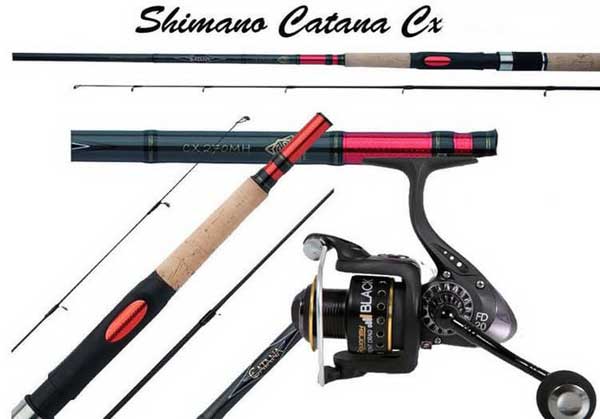
Norstream Voyager Telespin
Comfortable and lightweight spinning rod up to 300 cm long and weighing up to 170 grams. Allows you to fish with baits weighing from 5 to 25 grams. When folded, it takes up to 56 cm.
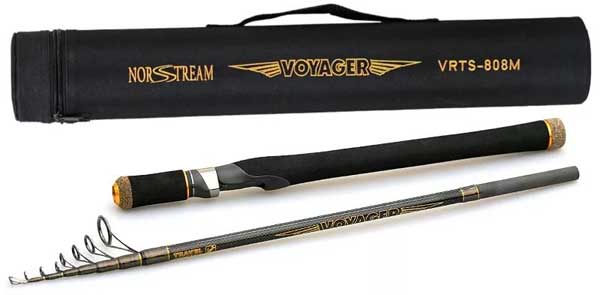
Categories of “telescopes” depending on the test range
The test range is information about the mass of baits that can be used during fishing so as not to damage the instrument. The first number is the minimum recommended weight, the second is the maximum. It is important to observe these characteristics of the device when choosing, this will greatly simplify and extend the life of the fishing rod.
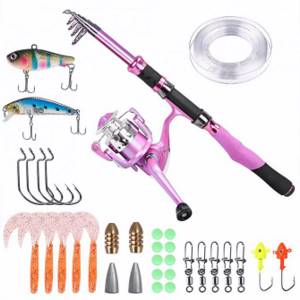
Types of spinning rods according to tests:
- the lightest (ultralight) - bait weighing up to 7 g;
- light – from 7 to 18 grams;
- medium – 18-40 grams (the most popular class of “telescopes”);
- heavy - the weight of the bait can exceed 40 g.
Also, when choosing a “telescope” you should be guided by the casting length. Spinning rods up to 2 m are chosen when fishing from the shore, where there are a lot of trees, or boats, up to 3.6 m - in wide and large water areas, 4.2 m - for ultra-long casts.
There are many models from different manufacturers on the Russian market, but the Shimano Katana spinning rod boasts the greatest variety and popularity. Thanks to Geofibre and Vibraspot material instead of expensive woven tape, fishing occurs with maximum comfort. In addition, thanks to the distribution of weight along the entire length of the rod, you can pull out a fairly large catch.
How to choose a spinning rod depending on the length
The normal length of a spinning rod is from two to three meters. When purchasing a spinning rod for the first time, the optimal length would be two and a half meters (plus or minus ten centimeters). When fishing from the shore in large areas of water, it is better to choose a spinning rod about three meters long.
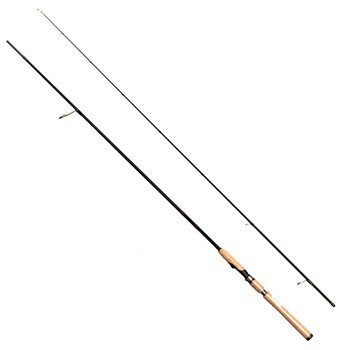
In not very wide rivers, the recommended rod length should not exceed two meters. It is important to understand that both the casting distance of the bait and the nature of landing the fish on the shore will depend on the length of the spinning rod. Short spinning rods are more mobile and compact, which is an advantage when fishing in cramped conditions. When choosing the length of the rod, you need to decide where exactly you are going to fish from: from the shore or from a boat. For fishing from a boat, experts recommend a rod length of up to 2.4 meters. When fishing from the shore, the length of the spinning rod can be from 2.7 meters and above. If you plan to fish both from a boat and from the shore, then it is better to choose a rod length from 2.3 to 2.6 meters. However, it would be more correct to purchase two spinning rods of different lengths: one for the shore, the other for the boat. Among other things, when choosing a spinning rod by length, you need to decide how far you want to throw the bait. Long rods will cast the bait further, and short rods will cast the bait closer to the shore.
Review of telescopic spinning rod models
Considering the growing popularity of telescopic spinning rods among both professionals and amateurs, we present an overview of the most popular rods purchased by Russian fishermen.
Review of “telescopes” that are in greatest demand among Russian consumers:
1. Spinning rod “Shimano Katana” CX Telespin
A high-quality, rigid and powerful rod, but at the same time sensitive, regardless of the fishing line used. The cost of the model is from 5.5 thousand rubles.
2. Shimano Exage BXST CMini Tele Spinn
Compact, pole length varies from 1.8 to 2.7 m. Thanks to the advanced reel seat, the highest sensitivity is ensured. Price – 7.5-11.5 thousand rubles.
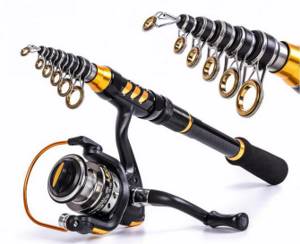
3. Daiwa SC-FA 48UL
Suitable for both beginners and professionals. Price – 5.5 thousand rubles.
4. Daiwa Neo Versal
Excellent combination of price and quality. Cost - from 3.5 to 6 thousand rubles.
5. Kosadaka Voyager
Balanced “telescope” model made of high quality carbon fiber. The fittings are lightweight, and fishing is as comfortable as possible.
Telescopic spinning rod, its structure, differences from plug-in spinning rod
A telescopic spinning rod is a fishing rod that, like an astronomical telescope, consists of retractable parts of varying lengths and thicknesses. The main components of such a spinning rod are:
- Knees are hollow cone-shaped tubes of various diameters that are inserted into each other.
- Passage rings are round metal frames with internal liners made of abrasion-resistant material (cermets, silicon carbide), which have a ring-shaped fastening and are located on the knee at the junction at the very end of the smaller one in diameter. A reinforced small tulip ring is installed on the last bend.
- A reel seat is a device for firmly and securely attaching a reel to a fishing rod. It consists of a support platform, a stop and a fixing element (nut), located in front or behind relative to the butt.
- Handle – in telescopes, the role of a handle can be performed by both the last knee and the handle itself, which is connected to the main part of the rod using a plug-in method. The material of the handle can be different - from cheap microporous rubber, which strongly absorbs moisture and dust, to cork, the distinguishing feature of which is lightness, strength, low thermal conductivity, and a pleasant-to-touch surface.
- Also included with the rod is a protective plastic cap that fits over the guide rings and protects them from damage when carried. At the top of the cap there is a hook with which the folded rod can be hung on a hanger hook fixed in the wall, thus saving space.
The length of a telescopic spinning rod in most cases ranges from 1.8 to 3-3.3 meters.
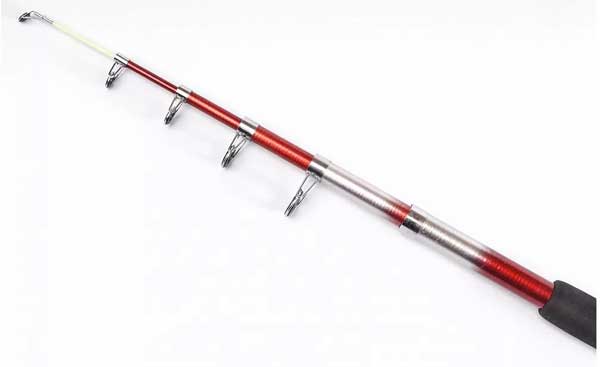
Test
Like plug-in spinning rods, the test of telescopic spinning rods divides them into 4 main classes based on the weight of the bait:
- ultra-light – suitable for fishing with light baits weighing no more than 7 grams;
- light – the weight of the baits thrown should be from 7 to 15 grams;
- medium – the weight range for rods of this class is from 15 to 30 grams;
- heavy – rods are designed to cast the heaviest baits weighing 30-40 grams or more.
Build
The structure of a telescopic spinning rod is:
- super fast - only the upper part of the tip reacts to load;
- fast - the entire tip bends;
- medium – at least half of the form is subject to bending;
- slow - the whip bends more than half.
Material of manufacture
Telescopic spinning rods are made from materials such as:
- Fiberglass - rods made from this cheap material are rigid, heavy, but at the same time unpretentious and have an affordable price for any angler.
- Composite is a material that is a mixture of cheap and rigid fiberglass and strong and flexible carbon fiber. Fishing rods made of composites are more unpretentious than graphite rods, while being more flexible than fiberglass rods.
- Carbon fiber (carbon) – when carbon fiber is used as a material for the manufacture of telescopic spinning rods, light and durable fishing rods are obtained that are highly flexible and perfectly hook fish. The disadvantage of such spinning rods is their fragility when hitting the edges of hard objects, stones, or falling onto a concrete floor.
We recommend reading: Winter fishing for bream on a rocker, making your own rig
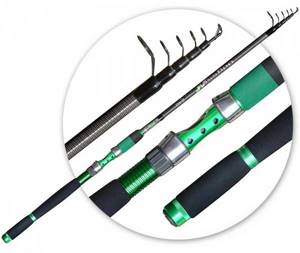
Features of plug spinning rod: pros and cons
Still wondering which spinning rod is better: telescopic or plug-in? We present an overview of the latest option. This species is most often chosen by fishing professionals.
Advantages of a plug rod:
- strength and resistance to mechanical stress, also wear resistance when catching fairly large fish;
- the length of the models can reach 7 m, so they can be used both in clear waters and in reservoirs where the shore cannot be approached due to vegetation;
- long-distance casting occurs without serious effort, the tackle does not break;
- the test of a plug-in spinning rod is quite high when compared with “telescopes” (designed for the large weight of the bait);
- high power and thickness of line.
Professionals also note the accuracy of casting when using the plug type, although this function is more difficult for a beginner to master. Despite the large number of advantages, there are also disadvantages to the work. So, such a fishing rod is difficult to transport; if it breaks, it cannot be repaired. The disadvantages also include high cost, but it primarily depends on the strength of the product and its service life.
Plug spinning rod is a product of high technology. The price depends on the material from which the fishing rod is made. Most often, this type is produced by companies in limited quantities rather than in mass production. Russian consumers order such tools to order and only in specialized stores.
The difference between plug and telescopic spinning rods
The main difference from is in the design features. A plug spinning rod usually consists of two legs, and they are not hollow. Thanks to this, plug-in spinning rods are designed to withstand significant loads. Telescopic spinning rod has a retractable rod design. It is less durable. Its main advantage is that it is compact and mobile
, which is important when transporting over long distances. When unfolded, a telescopic spinning rod can reach a length of up to three meters or more. All elbows of the telescopic rod are hollow, which reduces its strength. Other differences include cost. Telescopic spinning rods are traditionally cheaper than plug-in rods. However, the specific cost depends on the type of material. The second difference is the length of the rod. Plug rods are usually longer and lighter than telescopic rods. To transport plug-in spinning rods, special tubes are used. Telescopic analogues can easily fit into a hiking backpack. The third difference is in the features of repair and modification. Repairing and modifying a plug rod is much more difficult and requires significant investment. Repairing a telescopic spinning rod is much simpler and does not require the involvement of specialists. Another difference is in the features of application in practice. It takes less time to install a plug rod into the working position than a telescopic one. Experienced fishermen value the cooking process, so here they give preference to plug-in spinning rods. There is also a difference in the casting and retrieving systems. For example, the concept of “action” cannot be applied to telescopic fishing rods, since only the very top is always bent here. Fishing with telescopic spinning rods is more aggressive.
The best plug spinning rods
We present a review of plug rod models to get acquainted with the advantages and disadvantages of each model that is presented on the Russian market.
Rating of plug spinning rods:
1. Shimano Catana rod series
There are 13 models presented here with an optimal price-quality ratio. The Japanese company has developed a high-quality carbon rod with the highest possible action and high reliability. The fishing rods have a beautiful design, comfortable holders, light weight and are highly sensitive. But the guides are fragile and the reel seat is uncomfortable.
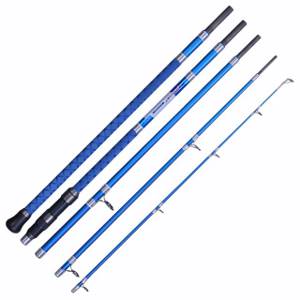
2. Daiwa INFINITY-Q 802 ULFS
A balanced spinning rod that is light weight, high quality, reliable and sensitive, has a strong ring system and is universal. But the handle is not for everyone and there is a risk of breaking the connection.
3. G. Loomis SR 842-2 IMX
An American-made model, which is distinguished by high quality workmanship, comfort of use, beautiful design, durability and the presence of a cover. Among the disadvantages, one can note the high cost.
4. Mikado Sakana Hanta Perch Spin 210 (WAA370-210)
Budget spinning rod, which is aimed at catching small fish. It is distinguished by its low price, good quality, comfortable handle, light weight and universal length. But the ring system is poor and reliability is low.
Criteria for choosing a spinning rod
The comparison of plug-in and telescopic spinning rods presented above will help you understand the nuances of how these tools work. But there are also other factors that need to be taken into account when choosing a fishing rod, regardless of its type.
What to look for when choosing a fishing rod:
- spinning class (ultra-light, light, medium or heavy) - it depends on the bait and its weight that will be used when fishing;
- type of rods (medium, hard or parabolic) - parabolic ones bend along the length and ensure a smooth casting of the bait, medium ones - in the upper part of the spinning rod, therefore they are used for long distances, hard ones - only the upper part bends;
- spinning test - the most suitable option is 2-25 g, suitable for any baits and water areas;
- action (fast, slow or medium) is the ability of a fishing rod to bend under load.

It is also important to determine such characteristics of the spinning rod as power, material of manufacture, length of the rod itself, reel seat and sensitivity of the tool.
Build
The structure of the rod shows the flexibility of the spinning rod, its plasticity and sensitivity.
The following formations are distinguished:
1. Slow tuning (S). Slow action rods are the most flexible. A serious drawback of plastic rods is poor sensitivity, for this reason they are not used in Ultralight and microjig. The advantage of a slow action is the ability to cast over long distances. 2. Fast action (F), indicates that only the first joint of the form bends. The rod allows you to feel even the weakest strikes, but does not allow you to make long casts. 3. Medium tuning (M) or medium-fast tuning has received the most attention and is considered universal. These forms combine the qualities of the first two formations and are suitable for most types of fishing.
Well-known fishing rod manufacturers
Global fishing rod manufacturing companies do not specialize in any one type or model, but have a fairly wide range. Thus, most often small-sized plug-in and telescopic spinning rods on the Russian market are presented by Japanese companies. Shimano is famous for its high quality, has a good long-standing reputation, as well as a varied price range.
There is also another Japanese manufacturer on the Russian market, Daiwa, which is engaged in the mass production of spinning rods, both plug-in and telescopic. It is distinguished by its reliability, as well as the constant use of innovations in its products.
The American company G Loomis offers a small and highly specialized tool for fishing. Every year it conquers new markets. Another American brand, Fenwick, is distinguished by high quality, low prices and reliability.
The top five global brands of fishing rods also include the Polish company Mikado, which sells products throughout Europe. The rods have good characteristics and are therefore in great demand. This company has only recently entered the Russian market.
TOP 3 budget fishing rod options for beginners
Professionals note that beginners in fishing should pay attention to the budget options for fishing rods, which are presented below.
Budget options for spinning rods:
1. Shimano ALIVIO CX SUPER SENSITIVE 300 ML
The best budget model with a length of 2.4 m (folded – 1.23 m). The bait used here is from 3 to 15 g. The rod is stable, has a high-power blank, and can be fished both from the shore and from a boat.
2. Black Hole Junior 632M/10-35
A rod for fishing enthusiasts and also an ideal option for beginners. The tackle is short in length and copes well with any bait. When folded, the design is quite compact.
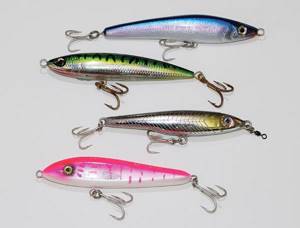
3. Maximus Work Horse SWH21M
The most budget model, which is distinguished by its universal design. The handle is ergonomic, the design is reliable and highly sensitive, but it is not suitable for catching large fish.
The best cheap spinning rods for jigging
We present a review of plug-in and telescopic spinning rods for jigging, which are in greatest demand among Russian consumers.
ZEMEX Spider Pro 270 5-28g fast takes first place and is suitable for anglers who are just starting out. The model is suitable for both light and heavy baits. Most often chosen for catching perch. This is a universal option at an affordable price, which has a beautiful appearance, is durable and casting accurately.
In second place is Maximus Wild Power-X SWPX27H. This model is distinguished by high quality, light weight, affordable price and durability. In third place is Aiko Troutex TRO180UL. It is characterized by a rigid structure, an ergonomic handle, and has good sensitivity, but sometimes the line gets caught between the rings.
Which spinning rod is better - plug-in or telescopic?
The answer to this question is individual and depends on many factors, but still, most fishermen, regardless of their skills, are inclined to use a two-armed rod. It is compact and reliable.
However, "telescopes" can also come in handy. Indeed, for some, compactness plays the most important role. In addition, this option is suitable as a backup. If you choose a telescopic spinning rod from leading brands, its quality may not be noticeable in comparison with plug-in rods. Recently, companies have been releasing fairly high-quality models that have excellent characteristics that delight even professionals.
